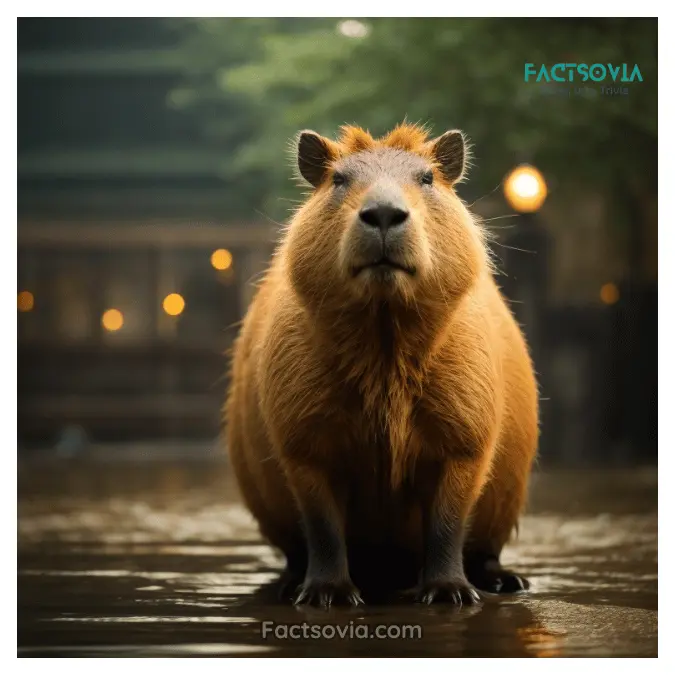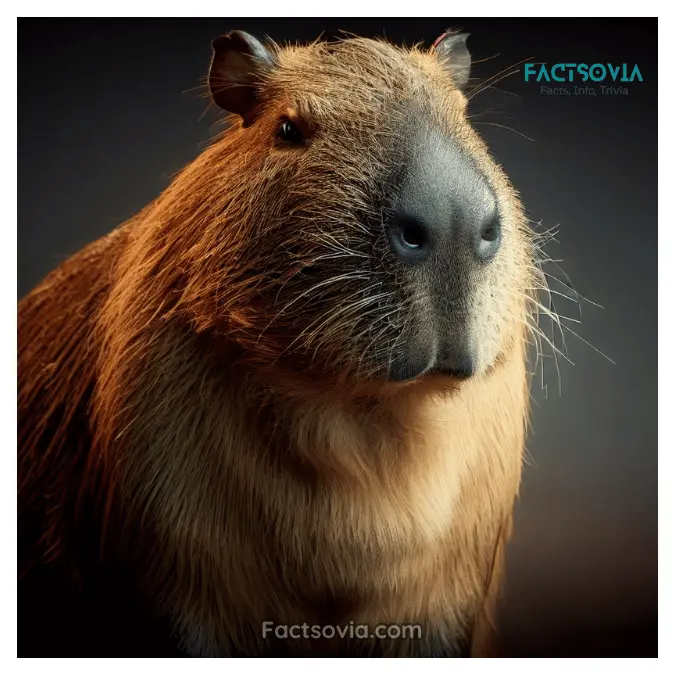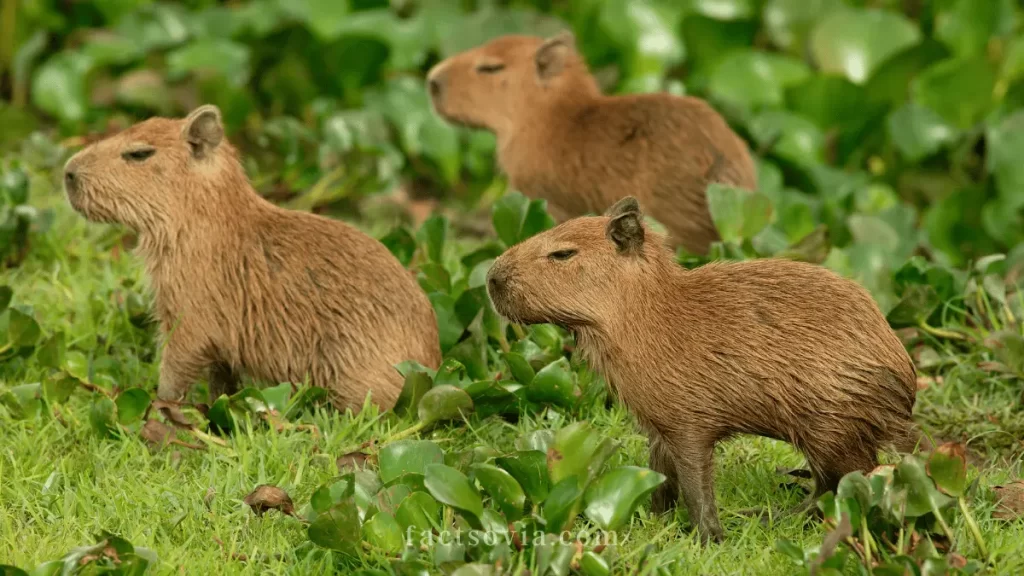We use affiliate links to run our site. When you buy through links on our site, we may earn an affiliate commission, without any added cost to you. Learn more
The capybara, also known as the giant rodent, is one of the largest rodents in the world. It can grow to be quite sizable, with some individuals reaching lengths of up to four feet. This impressive size has earned them the title of “giant” within the rodent family.
Capybaras have a unique appearance, resembling a cross between a guinea pig and a giant hamster. They have stout bodies, short legs, and a broad head.
Their large, round eyes give them a cute and friendly expression that adds to their charm. Despite their bulky build, capybaras are surprisingly agile in the water, where they spend a significant amount of their time.
How Big Is A Capybara?
Capybaras are often a topic of awe and surprise due to their surprisingly large size. These creatures can reach lengths of over 4.5 feet and weigh up to 150 pounds.
That’s equivalent to the size of a small adult human! When you first encounter a capybara, you might find yourself taken aback by its sheer dimensions.
It’s hard to believe these furry creatures, resembling slightly larger guinea pigs, can grow to such impressive sizes.
A Capybara’s Dimensions
Capybaras, a rather unique creature, are surprisingly large in size. They have an impressive length and height that sets them apart from most animals.
In fact, these giant rodents can grow to be about four and a half feet in length and stand up to two feet tall at the shoulder. That’s taller than your average dog! With such dimensions, it’s no wonder capybaras have become quite the curiosity among animal lovers.
When comparing capybaras to other animals, their size stands out even more. These rodents may not be as tall as a giraffe or as long as a python, but their dimensions are still impressive considering their species.
To put it into perspective, a fully-grown capybara can easily outweigh a grown man, clocking in at an average weight between 75 and 150 pounds.
That’s like carrying around a small to medium-sized dog! Whether you’re captivated by their unique size or simply fascinated by their proportions, capybaras are truly worth exploring.
Comparing Capybaras to Other Animals

Capybaras are one of the largest rodents in the world. In fact, they can grow to be much bigger than your average household pet. These cute and lovable creatures are about the size of a medium-sized dog, but they have a unique appearance that sets them apart from other animals.
Their large, round bodies are covered in short, dense fur, and they have a distinctively flat head with small ears and eyes. Compared to other animals, capybaras have a truly impressive size.
When it comes to comparing capybaras to other animals, their dimensions are quite astonishing. For instance, a fully grown capybara can reach a height of around 2 feet at the shoulder, making them taller than most small-sized dogs.
In terms of length, these gentle giants can stretch up to 4 feet long, making them longer than many household cats.
But what really sets capybaras apart is their weight. Adult capybaras can weigh anywhere between 77 to 146 pounds, which is undeniably heavier than your average household pet.
The Height of a Capybara
Capybaras, also known as the giant rodents, are fascinating creatures with surprisingly large physical dimensions. Their height, in particular, is quite impressive.
Standing on four short but sturdy legs, capybaras can reach up to 2 feet tall at the shoulder. This means that when they stand on their hind legs, they can often reach heights of over 3 feet, quite taller than many other animals of their size.
The height of a capybara is an important aspect of their overall size. It allows them to navigate through their natural habitat, which consists of grassy plains and wetlands.
With their height, capybaras can easily spot potential predators, such as jaguars or caimans, and make a quick getaway by diving into the water.
Furthermore, their long legs enable them to wade through shallow waters and swim efficiently, adding another dimension to their exceptional adaptation skills in their ecosystems.

Capybara Length: Impressive Measurements
Capybara length is truly awe-inspiring, to say the least. These giant rodents can reach incredible measurements that leave us humans astounded. With an average length of around 4 to 4.5 feet, capybaras easily surpass the dimensions of most other rodents. Just imagine encountering a creature that is almost as long as a tall person!
To put it into perspective, let’s compare capybaras to some other animals. While a capybara may not be as long as a crocodile or a snake, it certainly holds its own among its rodent relatives. They outstretch other popular rodents like guinea pigs and hamsters by a long shot. Capybara length truly highlights the unique nature of these animals as they tower over their smaller counterparts.
The size of a capybara is not to be underestimated. Their impressive length is just one aspect of their incredible proportions. Understanding the full range of their size variations is key in appreciating the sheer magnitude of these creatures. Let’s delve deeper into the world of capybaras and explore the fascinating differences in their sizes.
Understanding Capybara Weight
Capybaras, those incredible giant rodents, are not only impressive in size but also in weight. On average, adult capybaras weigh between 77 to 146 pounds (35 to 66 kilograms). That’s like having a small person sitting on your lap!
Intersetingly, these adorable creatures are well adapted to carry their weight with ease. Their stocky bodies and strong legs help them navigate both land and water, making them fantastic swimmers.
The weight of a capybara varies depending on factors such as age, gender, and health. Males tend to be larger and heavier than females, often reaching the upper end of the weight range. Additionally, younger capybaras may weigh less as they are still growing and developing.
It’s fascinating how these gentle giants manage to maintain their weight while munching on their favorite foods like grasses, water plants, and even some vegetables.
Capybara Size in Relation to Humans
Despite their large size, capybaras have a friendly and docile demeanor, which only adds to their charm. When standing next to a capybara, you might notice that they are slightly lower than us, but their bulky frame makes up for their lack of height.
It’s interesting to see how something so different from us in scale can coexist harmoniously with humans. The fact that capybaras can grow even bigger in certain cases – reaching weights of up to 200 pounds – just goes to show how incredible nature’s diversity can be.

Exploring Capybara Size Variations
Capybaras vary in size depending on various factors such as age, sex, and habitat. While the average capybara can measure around 3 to 4 feet in length and stand about 2 feet tall at the shoulder, there can be quite a bit of size variation within the species.
For instance, adult males tend to be larger than females, often reaching weights of up to 150 pounds or more. On the other hand, females typically weigh between 100-135 pounds.
Additionally, capybaras living in different regions may also exhibit some size differences. Those found in the wetlands of South America, where they primarily inhabit, tend to be larger compared to those living in the drier areas.
It’s quite fascinating to see how the capybaras adapt and adjust their size to their specific environments.
Amazon and the Amazon logo are trademarks of Amazon.com, Inc, or its affiliates.
